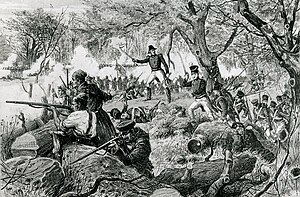The colonial militias in Canada were made up of various militias prior to Confederation in 1867. During the period of New France and Acadia, Newfoundland Colony, and Nova Scotia (1605-1763), these militias were made up of Canadiens, First Nations, British and Acadians. Traditionally, the Canadian Militia was the name used for the local sedentary militia regiments throughout the Canadas.
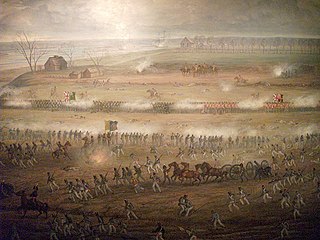
The Battle of Crysler's Farm, also known as the Battle of Crysler's Field, was fought on 11 November 1813, during the War of 1812. A British and Canadian force won a victory over a US force which greatly outnumbered them. The US defeat prompted them to abandon the St. Lawrence Campaign, their major strategic effort in the autumn of 1813.
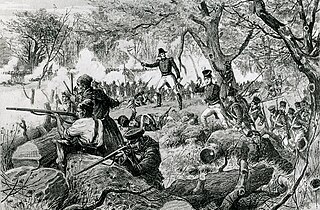
The Battle of the Chateauguay was an engagement of the War of 1812. On 26 October 1813, a combined British and Canadian force consisting of 1,530 regulars, volunteers, militia and Mohawk warriors from Lower Canada, commanded by Charles de Salaberry, repelled an American force of about 2,600 regulars which was attempting to invade Lower Canada and ultimately attack Montreal.

The Royal 22nd Regiment is an infantry regiment of the Canadian Army. Known colloquially in English as the Van Doos or in French as le Vingt-deuxième, the mostly francophone regiment comprises three Regular Force battalions, two Primary Reserve battalions, and a band, making it the largest regiment in the Canadian Army. The headquarters of the regiment is at the Citadelle of Quebec in Quebec City, also the site of the regimental museum, and all three of its regular battalions are stationed at Canadian Forces Base Valcartier in Saint-Gabriel-de-Valcartier, 15 kilometres (9.3 mi) outside of Quebec City. The regiment serves as the "local" infantry regiment for the province of Quebec, where it draws most of its recruits.
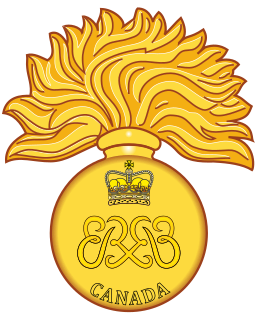
The Canadian Grenadier Guards (CGG) is a reserve infantry regiment in the 34 Canadian Brigade Group, 2nd Canadian Division, of the Canadian Army. The regiment is the oldest and second-most-senior infantry regiment in the Primary Reserve of the Canadian Army. Located in Montreal, its primary role is the provision of combat-ready light infantry troops in support of Canadian regular infantry. It is a Household Foot Guard regiment and also provides soldiers for public ceremonial duties, performing similar ceremonial duties to the Guards regiments of the British Army. This primarily entails mounting the guard on Government House, the Governor General's residence, and performing the "Changing the Guard" ceremony on Parliament Hill in Ottawa, a task it shares with Canada's senior Household Foot Guard regiment, the Governor General's Foot Guards of Ottawa. The Canadian Grenadier Guards is an allied regiment to the British Grenadier Guards.

Charles-René-Léonidas d'Irumberry de Salaberry was a French-Canadian militia officer, founding commanding officer of Les Voltigeurs de Québec, and civil servant noted for his role in negotiating on the behalf of the Government of Canada during the Red River Rebellion of 1869–1870. His father, Charles-Michel d'Irumberry de Salaberry was a hero of the Battle of Chateauguay during the War of 1812.

Le Régiment de Hull (RCAC) is a Primary Reserve armoured reconnaissance regiment of the Canadian Army. The regiment is based in the Hull sector of Gatineau, Quebec, near Ottawa, Ontario. Active in all aspects of the day-to-day life of Outaouais residents, the unit is the only francophone military presence in the area.

Les Voltigeurs de Québec is a Primary Reserve infantry regiment of the Canadian Forces. It is located at the Quebec City Armoury in Quebec City, Quebec, Canada. The name of the regiment commemorates another older French-speaking Canadian militia light infantry unit, the Canadian Voltigeurs. The founder of the Canadian Voltigeurs, Lieutenant-Colonel Charles-Michel d'Irumberry de Salaberry, was the father of the two men who raised Les Voltigeurs de Québec. The regiment was formed in March 1862, with its headquarters in Quebec City, by the amalgamation into a regiment of eight independent Volunteer Militia Rifle companies. The first of these companies was originally raised in December 1861. Between 1862 and 1867 these companies were frequently disbanded, reformed and renumbered. In 1942 it provided an armoured regiment.
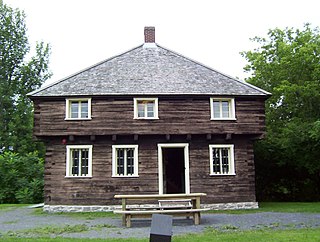
The Battle of Lacolle River was fought on November 20, 1812, during the War of 1812. In this relatively light skirmish, a very small garrison of Canadian militia, with the assistance of Kahnawake Mohawk warriors, defended the Lacolle Mills Blockhouse on the Montreal road bridge over the Lacolle River at the village of Lacolle, Quebec against a disorganized American attack.

The Battle of Lacolle Mills was fought on 30 March 1814 during the War of 1812. The small garrison of a British outpost position, aided by reinforcements, fought off a large American attack.
Frederick George Heriot was a British army officer, who fought in the War of 1812 and subsequently became a landowner and administrator in Canada.

When the United States and the United Kingdom went to war against each other in 1812, the major land theatres of war were Upper Canada, Michigan Territory, Lower Canada and the Maritime Provinces of Nova Scotia, New Brunswick, Prince Edward Island and Cape Breton . Each of the separate British administrations formed regular and fencible units, and both full-time and part-time militia units, many of which played a major part in the fighting over the two and a half years of the war.
George Richard John Macdonell, commonly known as Red George, was an officer in the British Army who played a conspicuous part in the War of 1812.

A rifle regiment is a military unit consisting of a regiment of infantry troops armed with rifles and known as riflemen. While all infantry units in modern armies are typically armed with rifled weapons the term is still used to denote regiments that follow the distinct traditions that differentiated them from other infantry units.
Dominique Ducharme, from Lachine, Quebec, was a French Canadian fur trader, settler, militia officer, and public servant.

The Voltigeurs were French military skirmish units created in 1804 by Emperor Napoleon I. They replaced the second company of fusiliers in each existing infantry battalion.

Lacolle Mills Blockhouse is a blockhouse and museum located alongside the Lacolle River near the village of Lacolle, Quebec.
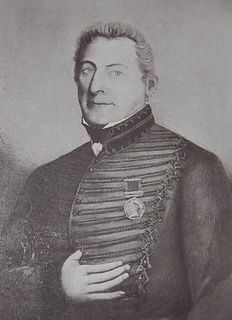
Lieutenant-Colonel Maximilien Globensky was a French-Canadian who fought for the British in the War of 1812 and for the loyalists in the Rebellions of 1837.
The Canadian Regiment of Fencible Infantry, commonly known as the Canadian Regiment or the Canadian Fencibles, saw service in Upper and Lower Canada during the early 19th century, notably during the Anglo-American War of 1812.
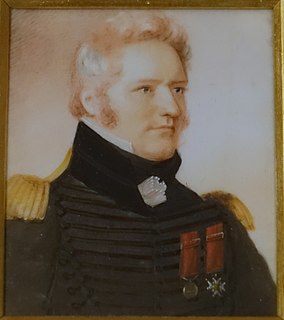
Lieutenant Colonel Charles-Michel d'Irumberry de Salaberry, CB was a Canadian military officer and statesman of the seigneurial class who served in various campaigns for the British Army. He won distinction for repelling the American advance on Montreal during the War of 1812.
